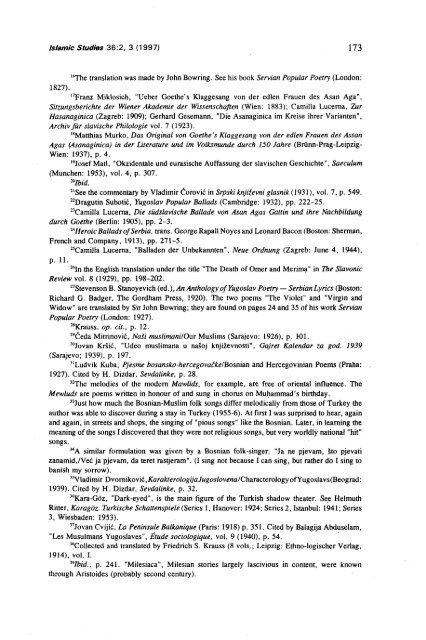Create successful ePaper yourself
Turn your PDF publications into a flip-book with our unique Google optimized e-Paper software.
Islamic Studies 36:2, 3 (1997) 173<br />
'The translation was made by John Bowring. See his book Servian Popular Poetry (London:<br />
1827).<br />
I7Franz Miklosich, "Ueber Goethe's Klaggesang von der edlen Frauen des Asan Aga",<br />
Sitzungsberichte der Wiener Akademie der Wissenschajten (Wien: 1883); Camilla Lucema, Zur<br />
Hasanaginica (Zagreb: 1909); Gerhard Gesemann, "Die Asanaginica im Kreise ihrer Varianten",<br />
Archiv filr slavische Philologie vol. 7 (1923).<br />
InMatthias Murko, Das Original von Goethe's Klaggesang von der edlen Frauen des Assan<br />
Agas (Asanaginica) in der Literature und im Volksmunde durch 150 Jahre (Brunn-Prag-Leipzig-<br />
Wien: 1937). p. 4.<br />
'"Josef Matl, "Okzidentale und eurasische Auffassung der slavischen Geschichte", Saeculum<br />
(Munchen: 1953), vol. 4, p. 307.<br />
"Ibid.<br />
2'See the commentary by Vladimir Corovit in Srpskiknjiievniglasnik (1931). vol. 7, p. 549.<br />
"Dragutin Subotit, Yugoslav Popular Ballads (Cambridge: 1932). pp. 222-25.<br />
'3Camilla Lucerna, Die siidslavische Ballade van Asan Agas Gattin und ihre Nachbildung<br />
durch Goethe (Berlin: 1905), pp. 2-3.<br />
24Heroi~ Ballads of Serbia, trans. George Rapall Noyes and Leonard Bacon (Boston: Sherman,<br />
French and Company, 1913). pp. 271-5.<br />
25Camilla Lucerna, "Balladen der Unbekannten", Neue Ordnung (Zagreb: June 4, 1944).<br />
p. 11.<br />
'"In the English translation under the title "The Death of Omer and Merima" in The Slavonic<br />
Review vol. 8 (1929). pp. 198-202.<br />
27Stevenson B. Stanoyevich (ed .), An Anthology of Yugoslav Poetry - Serbian Lyrics (Boston:<br />
Richard G. Badger, The Gordham Press, 1920). The two poems "The Violet" and "Virgin and<br />
Widow" are translated by Sir John Bowring; they are found on <strong>page</strong>s 24 and 35 of his work Servian<br />
Popular Poetry (London: 1927).<br />
2nKrauss, op. cit.. p. 12.<br />
'"Ceda Mitrinovit, NaSi muslimanilOur Muslims (Sarajevo: 1926), p. 101.<br />
3"Jovan KrSiC, "Udeo muslimana u naSoj knjiievnosti", Gajret Kalendar za god. 1939<br />
(Sarajevo; 1939), p. 197.<br />
3'Ludvik Kuba, Pjesme bosansko-hercegovatke1Bosnian and Hercegovinian Poems (Praha:<br />
1927). Cited by H. Dizdar, Sevdalinke, p. 28.<br />
"The melodies of the modem Mawlids, for example, are free of oriental influence. The<br />
Mewluds are poems written in honour of and sung in chorus on Muhammad's birthday.<br />
"Just how much the Bosnian-Muslim folk songs differ melodically from those of Turkey the<br />
author was able to discover during a stay in Turkey (1955-6). At first I was surprised to hear, again<br />
and again, in streets and shops, the singing of "pious songs" like the Bosnian. Later, in learning the<br />
meaning of the songs I discovered that they were not religious songs, but very worldly national "hit"<br />
songs.<br />
34A similar formulation was given by a Bosnian folk-singer: "Ja ne pjevam, Sto pjevati<br />
zanamid,lVeC ja pjevam, da teret rastjeram". (I sing not because I can sing, but rather do I sing to<br />
banish my sorrow).<br />
"Vladimir DvornikoviC,KarakterologijaJugoslovena/ChacterologyofYugoslavs(Beograd:<br />
1939). Cited by H. Dizdar, Sevdalinke, p. 32.<br />
3LKara-Goz, "Dark-eyed", is the main figure of the Turkish shadow theater. See Helmuth<br />
Riner, Karagoz. Turkische Schattenspiele (Series 1, Hanover: 1924; Series 2, Istanbul: 1941; Series<br />
3, Wiesbaden: 1953).<br />
'7Jovan CvijiC, La Peninsule Balkanique (Paris: 1918) p. 351. Cited by Balagija Abduselam,<br />
"Les Musulmans Yugoslaves", ~tude sociologique, vol. 9 (1940). p. 54.<br />
3XCollected and translated by Friedrich S. Krauss (8 vols.; Leipzig: Ethno-logischer Verlag,<br />
1914). vol. I.<br />
'Ibid., p. 241. "Milesiaca", Milesian stories largely lascivious in content, were known<br />
through Aristoides (probably second century).
















